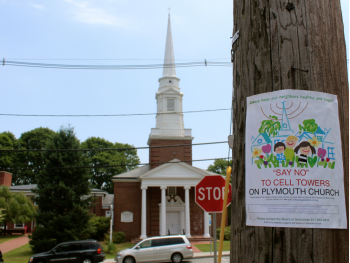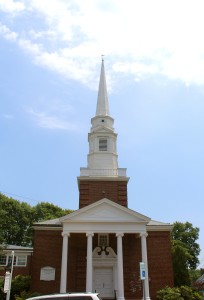Photo: Attorney Ted Hess-Mahan (standing) addressing the Historic District Commission with Pleasant Street resident Glenn Herosian (seating, right) listening.
“Simple fairness.”
For Glenn Herosian, that is the primary reason he and many of his neighbors are aggressively averse to a cellular network’s antenna in the steeple of the Plymouth Congregational Church on Pleasant Street.
The lack of fairness Herosian refers to is the perception the town is allowing the church to skirt the rigid design and material guidelines enforced on every structure within the historic district for a second time in three years.
“[The church] thinks they can bowl everyone over, and they’re not going to do it this time,” the Pleasant Street resident told the Belmontonian who, along with two dozen supporters, came before the Historic District Commission on Tuesday, Feb. 9 to preview their opposition to the church’s anticipated request to the commission at its March meeting where it and the telecommunication giant Verizon “hopes to continue the historic degradation of the church.”
The protestors complaints come the same week contractors hired by telecommunication firm Verizon were performing non-specific construction on the steeple to prepare it for the installation of a cellular antenna system, which the complainants contend is being done without a proper building permit.
While Herosian and his supporters believe the current work is in violation of the state building code, the town department says the church can move forward with the work.
“As of now the work is related solely to Verizon and does not require a building permit,” Glenn Clancy, director of the Office of Community Development, told the Belmontonian Wednesday, Feb. 10.,
“The Verizon work is allowed as it would be for any private property owner” with the owner taking the “risk onto themselves” if the permit is ultimately not issued, said Clancy.
For Hersoian and the 95 residents who have signed a petition supporting his efforts – he said he will have more than 150 by next month – the Historic District Commission is seen by the church’s abutters and neighbors as their final bulwark against the proposed alterations.
Last month, the Belmont Planning Board approved the design and site plan review to place the antenna inside the structure which Rev. Joseph Zarro, Plymouth’s spiritual leader, in 2014 said would be a “win-win” for the church and community.
The Planning Board did include a condition to its opinion in which the Historic Commission is to review the proposal before a building permit is issued.
With that caveat in hand, Herosian and his supporters are seeking to sway the Commission to invalidate the Planning Board’s approval by agreeing that the building’s aesthetics will be further compromised if the work the church outlined to the Planning Board is allowed to proceed.
“They are taking an incredibly important landmark that the town has in the Historic District and are degrading it,” said Herosian.
For the cellular equipment to function properly will require the existing louvers (wooden shutters with horizontal slats) to be replaced with fiberglass replicas, compounding what Herosian called the “degradation” of the building when the commission approved – against evidence from preservation experts – replacement columns and railings in August 2013 he said was made with composite material and “cheap” plastic covering that has not weathered well over the past three years.

Herosian, who lives with his wife, Karen, in a 60-year-old renovated custom ranch across Pleasant Street from the church, said he looks at the church out his sweeping front window every day wondering how a landmark was allowed to make major renovations outside the strict regulations imposed on all property owners.
“We went through the same historic district review, and it saved us from ourselves,” said Herosian as suggestions and rules resulted in a better design and project on his house.
“If this is allowed to stand this will likely have a devastating adverse impact on the fabric of our community, the entire Pleasant Street Historic District and the Belmont Historic Commission itself,” said Ted Hess-Mahan, the Herosian’s attorney who presented their case to the commission.
While the protestors are seeking the reversal of the 2013 Commission decision on the columns and railings as well as a denial of the current changes, Commission Chair Joseph Cornish said overturning an existing ruling “has never happened in our history.”
Herosian said he hoped to work with the church in securing Community Preservation Commission funds to repair and return the building “to its original beauty.”
The church’s governing board said in a 2014 article in the Belmontonian that a long-term lease – typically lasting more than 20 years and can bring in up to $2,000 to $4,000 a month in rent – will allow the church to renovate the building and expand social service activities. It is not known the contents of the contract signed between Verizon and the church.
Also, Clancy believes the church and town have done their due diligence on all possible objections, referring to the approvals by the Planning Board in January and three years ago from the Historic District Commission.
“We are aware of the allegations. I think the Town is on solid ground,” said Clancy.
But Herosian is adamant that supporters will not be pushed aside and ignored as, he claims, opponents were during the Planning Board decision. He has filed a formal complaint against the town stating that required mailed notification of the hearing to abutters was not delivered to several neighbors, reportedly due to errors in the addresses on mailers.
Herosian is seeking the reopening of the Planning Board hearing to allow additional information to be submitted and voicing opinions from the neighborhood.
But for now, Herosian focus is square on the Historic District Commission.
“This is far from over,” he said.
